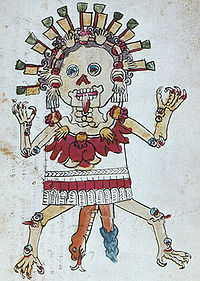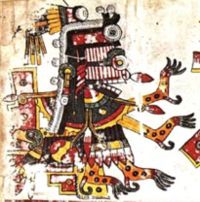
Tzitzimime
Encyclopedia

Aztec mythology
The aztec civilization recognized a polytheistic mythology, which contained the many deities and supernatural creatures from their religious beliefs. "orlando"- History :...
, a tzitzimitl (plural tzitzimimeh) is a deity associated with stars. They were depicted as skeletal female figures wearing skirts often with skull and crossbone designs. In Postconquest descriptions they are often described as "demon
Demon
call - 1347 531 7769 for more infoIn Ancient Near Eastern religions as well as in the Abrahamic traditions, including ancient and medieval Christian demonology, a demon is considered an "unclean spirit" which may cause demonic possession, to be addressed with an act of exorcism...
s" or "devils" - but this does not necessarily reflect their function in the prehispanic belief system of the Aztecs.

Cihuateteo
In Aztec mythology, the Cihuateteo were the spirits of human women who died in childbirth . Childbirth was considered a form of battle, and its victims were honored as fallen warriors...
and other female deities such as Tlaltecuhtli
Tlaltecuhtli
Tlaltecuhtli, Tlaltecutli is a pre-Columbian Mesoamerican deity figure, identified from sculpture and iconography dating to the Late Postclassic period of Mesoamerican chronology , primarily among the Mexica and other Nahuatl-speaking cultures...
, Coatlicue
Coatlicue
Coatlicue, also known as Teteoinan , "The Mother of Gods" , is the Aztec goddess who gave birth to the moon, stars, and Huitzilopochtli, the god of the sun and war...
, Citlalinicue and Cihuacoatl and they were worshipped by midwives and parturient women. The leader of the tzitzimime was the Goddess Itzpapalotl
Itzpapalotl
In Aztec mythology, Itzpapalotl was a fearsome skeletal warrior goddess, who ruled over the paradise world of Tamoanchan, the paradise of victims of infant mortality and place identified where humans were created. She is the mother of Mixcoatl and is particularly associated with the moth...
who was the ruler of Tamoanchan - the paradise where the Tzitzimimeh resided.
The Tzitzimimeh were also associated with the stars and especially the stars that can be seen around the sun during a solar eclipse. This was interpreted as the Tzitzimimeh attacking the sun, this caused the belief that during a solar eclipse
Solar eclipse
As seen from the Earth, a solar eclipse occurs when the Moon passes between the Sun and the Earth, and the Moon fully or partially blocks the Sun as viewed from a location on Earth. This can happen only during a new moon, when the Sun and the Moon are in conjunction as seen from Earth. At least...
, the tzitzimime would descend to the earth and devour human beings. The Tzitzimimeh were also feared during other ominous periods of the Aztec world, such as during the five unlucky days called Nemontemi which marked an unstable period of the aztec year count
Xiuhpohualli
The Xiuhpohualli was a 365-day calendar used by the Aztecs and other pre-Columbian Nahua peoples in central Mexico. It was composed of eighteen 20-day "months," called veintenas or metzli with a separate 5 day period at the end of the year called the nemontemi...
, and during the New Fire ceremony
New Fire ceremony
The New Fire ceremony was an Aztec ceremony performed once every 52 years — a full cycle of the Aztec calendar— in order to stave off the end of the world....
marking the beginning of a new calendar round - both were periods associated with the fear of change.
The Tzitzimimeh had a double role in Aztec religion: they were protectresses of the feminine and progenitresses of mankind. But they were also powerful and dangerous, especially in periods of cosmic instability.

